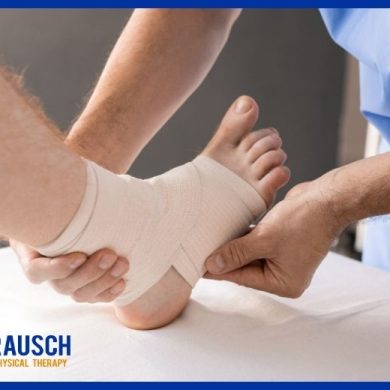At Rausch Physical Therapy and Wellness, we believe that movement is medicine—at every age and every stage of life. That’s why we’re excited to announce our new partnership with Fort Fitness,
The Fourth Trimester and Pelvic Floor PT
July 24, 2020 1:04 pm / Category: Uncategorized
The fourth trimester. The first 3 months after the birth of a child. New mothers are often consumed by their new baby and nothing else matters in the world, as you would and should expect. It is vital to check in on the newborn to ensure their health and development in their first few months out of the womb. However, what also tends to happen is that health care providers, such as the OB-GYN, and even the woman herself forget to attend to the health of the postpartum body. During this time the abdomen, pelvic floor, and vaginal canal are all healing. While it is normal to experience some after-effects of labor/delivery, there are some occurrences that happen that are absolutely not normal. It is the mission of pelvic floor PT specialists, myself included, to spread the word. Let’s remove the taboo and talk openly about what really happens after childbirth and what you can do to fix it.
First, let us establish how long it typically takes to recover from pregnancy and childbirth overall. A woman who goes through an average, non-complicated pregnancy, and vaginal delivery will recover 90-100% of her functional status prepartum between 9-12 months following childbirth. Non-complicated means without physician ordered bed rest, prescription medication use, episiotomy, or epidural injection at any point throughout the pregnancy. Pregnancy and delivery with complication and/or Caesarean section (C-section) will recover 90-100% of functional status prepartum 12+ months following childbirth. Then we have to consider, what is considered “normal” for your body during those first 3 months following childbirth? Normal after-effects and changes include bleeding or discharge, perineum soreness, nipple soreness, extremity swelling, hemorrhoids, constipation, and mild leaking. However, most of these issues should be resolved before the end of the fourth trimester.
OK, got that covered. So what about all that is abnormal? Most obviously, any of those issues that continue past the fourth trimester. Red flags that warrant an urgent return to your physician include continued bleeding and/or discharge, swelling, nausea/vomiting, fever, or general feelings of malaise that are unrelenting. Then there are the misconceptions the abnormal non-urgent issues are “just the way life is going to be now,” or are missed completely. If you have any of these problems, consult your physician and/or pelvic floor PT near you. Problems that can be addressed by pelvic floor physical therapy are as follows:
● Urinary incontinence with strong urges to urinate, or with increases in intra-abdominal pressure (i.e. cough, sneeze, laugh)
● Urinary frequency/urgency
● or painful defecation
● Pain with sexual intercourse (including sharp pain or diffuse soreness)
● Pelvic organ prolapse (symptoms include perineal discomfort and/or heaviness)
● Diastasis recti separation
● Perineal or C-section scar stiffness and/or sensitivity
● Weak pelvic floor and abdominal muscles
● Neck or back pain related to poor posturing (i.e. holding baby or breastfeeding positions)
Wow, you say. That’s quite the laundry list of problems! It is mind-boggling that so many women walk around postpartum without any form of treatment at all. We would like to think that if any of these issues were mentioned in the 6-week OB-GYN follow up appointment that they would offer or recommend hard solutions, including physical therapy. However, the role of OB-GYNs is to manage and control issues that require medical attention. They are not musculoskeletal experts, so we cannot expect them to solve those problems. In that regard, it makes sense that OB-GYNs and physical therapists should complement one another. There is also the unfortunate truth our healthcare system is not yet in a place to utilize physical therapy as the standard of care following labor and delivery. The good news is that European healthcare is already paving the way in maternal care and the United States should follow suit. We have an extensive basis of credible research demonstrating the value of pelvic PT, now all we need is to spread the word and make people aware of what is available. It is already the mission of pelvic floor therapists to provide education to those looking for it, now all we need is YOU! As the patient, you have so much power in not only talking to your family and friends but also in bringing your physician(s) this information as some have no idea that this type of PT even exists!
The last point to consider in the fourth trimester is your return to regular activity and exercise. Day one after labor and delivery the postpartum woman can begin to breathe through the diaphragm and practice gentle transverse abdominal contractions to stabilize the pelvis through transitional movements, such as rolling in bed, walking short distances, and going from sitting to standing. After the first 6 weeks, foundational exercises may begin and progress from there. I cannot stress it enough, seek advice from a pelvic PT if any of this information applies to you or someone you know. After all, happy and healthy babies begin with happy and healthy mommies!
 Dr. Rebecca Gasca, PT, DPT
Dr. Rebecca Gasca, PT, DPT
Let’s talk! We are here to help. Give us a call for a complimentary consultation. We would love to meet you.
Did you know there’s no prescription needed from a doctor to see us – but we will communicate your progress and treatment to your doctor if you’d like us too!
(949) 276-5401
Disclaimer — All the information that you find on our blogs and social media pages is for informational purposes only and is not intended to be used as your personal professional diagnosis, or treatment. Come and see us for your excellent, personalized care! https://rauschpt.net/






